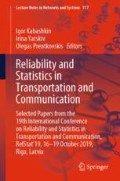Abstract
Because of seasonality of demand and periodicity of replenishments, inventory dynamics can be highly self-similar. This paper demonstrates that such metrics of fractal analysis as the Hurst exponent, correlation dimension and sample entropy indicate predictability of inventory dynamics by LSTM recurrent neural networks. From business point of view, this finding is useful, because one can spot time series with large self-similarity metrics prior to building the model saving time and computational budget as the result.
Access this chapter
Tax calculation will be finalised at checkout
Purchases are for personal use only
References
IHL-Group, Buzek, G.: Research study: we lost Australia! retail’s $1.1 trillion inventory distortion problem (2015)
Gardner, E.: Evaluating forecast performance in an inventory control system. Manage. Sci. 36(4), 490–499 (1990)
Spedding, T., Chan, K.: Forecasting demand and inventory management using Bayesian time series. Integr. Manufact. Syst. 11(5), 331–339 (2000)
Hochreiter, S., Schmidhuber, J.: Long short-term memory. Neural Comput. 9(8), 1735–1780 (1997)
Chen, K., Zhou, Y., Dai, F.: A LSTM-based method for stock returns prediction: a case study of China stock market. In: The 2015 IEEE International Conference on Big Data, pp. 2823–2824 (2015)
Mrazovic, P., Larriba-Pey, J., Matskin, M.: A Deep learning approach for estimating inventory rebalancing demand in bicycle sharing systems. In: 2018 IEEE 42nd Annual Computer Software and Applications Conference, pp. 110–115 (2018)
Yao, H., Wu, F., Ke, J., Tang, X., Jia, Y., Lu, S., Li, Z.: Deep multi-view spatial-temporal network for taxi demand prediction. In: 32nd AAAI Conference on Artificial Intelligence, pp. 217–226 (2018)
Qian, B., Rasheed, K.: Hurst exponent and financial market predictability. In: The IASTED Conference on Financial Engineering and Applications, pp. 203–209 (2004)
Eom, C., Choi, S., Oh, G., Jung, W.: Hurst exponent and prediction based on weak-form efficient market hypothesis of stock markets. Physica A: Stat. Mech. Appl. 387, 4630–4636 (2008)
Alvarez-Ramirez, J., Alvarez, J., Rodriguez, E., Fernandez-Anaya, G.: Time-varying Hurst exponent for US stock markets. Physica A: Stat. Mech. Appl. 387(24), 6159–6169 (2008)
Cui, D., Sun, Y.: A fractal-dimension-based study on optimization of spatial structure of Huzhou tourism scenic system. Sci. Geogr. Sinica 3, 9–15 (2011)
Soofi, A., Galka, A.: Measuring the complexity of currency markets by fractal dimension analysis. Int. J. Theor. Appl. Finance 6(06), 553–563 (2003)
Richman, J., Moorman, J.: Physiological time-series analysis using approximate entropy and sample entropy. Am. J. Physiol. Heart Circ. Physiol. 278(6), 2039–2049 (2000)
Yentes, J., Hunt, N., Schmid, K., Kaipust, J., McGrath, D., Stergiou, N.: The appropriate use of approximate entropy and sample entropy with short data sets. Ann. Biomed. Eng. 41(2), 349–365 (2013)
Nair, V., Hinton, G.: Rectified linear units improve restricted Boltzmann machines. In: The 27th International Conference on Machine Learning (ICML-10), pp. 807–814 (2010)
Anastassiou, G.: Multivariate hyperbolic tangent neural network approximation. Comput. Math Appl. 61(4), 809–821 (2011)
Graves, A., Jaitly, N., Mohamed, A.: Hybrid speech recognition with deep bidirectional LSTM. In: 2013 IEEE Workshop on Automatic Speech Recognition and Understanding, pp. 273–278 (2013)
Hurst, H.: Long-term storage capacity of reservoirs. Trans. Am. Soc. Civ. Eng. 116, 770–799 (1951)
Mandelbrot, B., Wallis, J.: Operational hydrology. Water Resour. Res. 4(5), 909–918 (1968)
Weron, R.: Estimating long-range dependence: finite sample properties and confidence intervals. Physica A: Stat. Mech. Appl. 312(1–2), 285–299 (2002)
Mandelbrot, B.: Limit theorems on the self-normalized range for weakly and strongly dependent processes. Z. Wahrscheinlichkeitstheorie verwandte Gebiete 31(4), 271–285 (1975)
Mandelbrot, B., Hudson, R.: The (Mis)Behaviour of Markets: A Fractal View of Risk, Ruin and Reward. Profile Books, London (2010)
Grassberger, P., Procaccia, I.: Measuring the strangeness of strange attractors. Physica: Nonlinear Phenom. 9(1–2), 189–208 (1983)
Moon, F.: Chaotic and Fractal Dynamics: Introduction for Applied Scientists and Engineers. John Wiley & Sons, Weinheim (2008)
Jackson, I., Tolujevs, J., Lang, S., Kegenbekov, Z.: Metamodelling of inventory-control simulations based on a multilayer perceptron. Transp. Telecommun. J. 20(3), 251–259 (2019)
Jackson, I., Tolujevs, J.: The discrete-event approach to simulate stochastic multi-product (Q, r) inventory control systems. Inf. Model. Knowl. Bases XXX 312, 32–39 (2019)
GitHub Repository “metainventory”: https://github.com/Jackil1993/metainventory. Accessed 24 Aug 2019
Gulli, A., Pal, S.: Deep Learning with Keras. Packt Publishing Ltd., Birmingham (2017)
GitHub Repository “Nolds”: https://github.com/CSchoel/nolds. Accessed 24 Aug 2019
Sychev, V.: Fractal analysis. FRACTAN 4.4., http://iki.rssi.ru/magbase. Accessed 24 Aug 2019
Author information
Authors and Affiliations
Corresponding author
Editor information
Editors and Affiliations
Rights and permissions
Copyright information
© 2020 Springer Nature Switzerland AG
About this paper
Cite this paper
Jackson, I., Grakovski, A. (2020). Combining LSTM Artificial Recurrent Neural Networks and Fractal Analysis for Inventory Dynamics Prediction. In: Kabashkin, I., Yatskiv, I., Prentkovskis, O. (eds) Reliability and Statistics in Transportation and Communication. RelStat 2019. Lecture Notes in Networks and Systems, vol 117. Springer, Cham. https://doi.org/10.1007/978-3-030-44610-9_3
Download citation
DOI: https://doi.org/10.1007/978-3-030-44610-9_3
Published:
Publisher Name: Springer, Cham
Print ISBN: 978-3-030-44609-3
Online ISBN: 978-3-030-44610-9
eBook Packages: Intelligent Technologies and RoboticsIntelligent Technologies and Robotics (R0)

